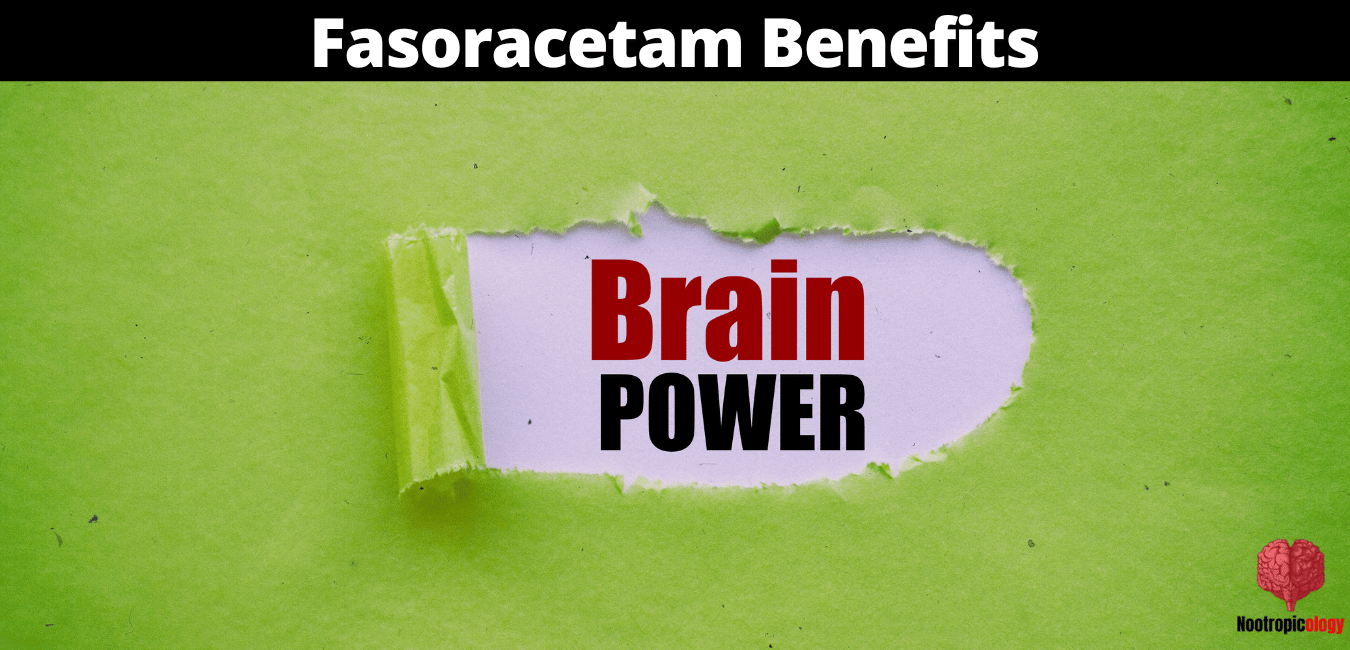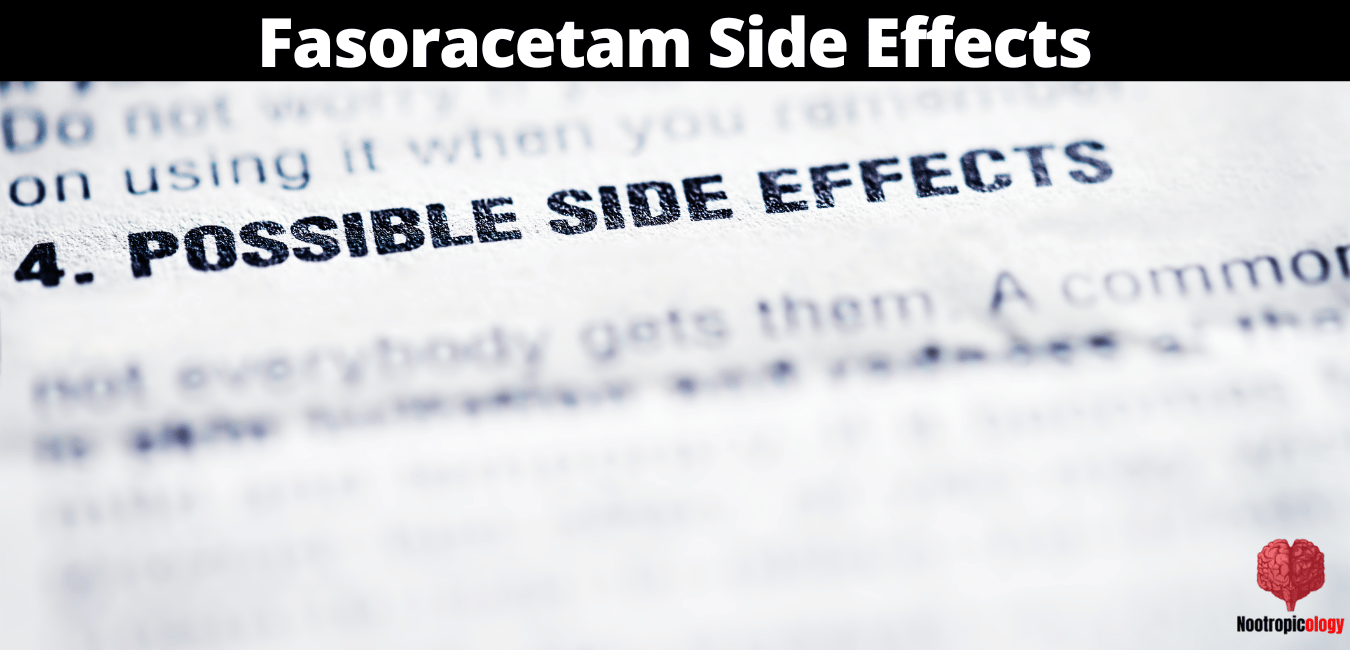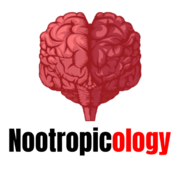Fasoracetam Nootropic Review: Benefits, Side Effects & Dosage
Fasoracetam, a member of the racetam family of drugs, has gained traction in recent years among nootropics enthusiasts and researchers.
As the world of cognitive enhancers expands, Fasoracetam stands out due to its unique pharmacological profile and promising therapeutic effects.
In this review, I will journey into the landscape of this compound, assessing its nootropic benefits, potential side effects, and recommended dosages.
So without further ado, let's dive in!
What is Fasoracetam?


Fasoracetam (NS-105) is a member of the racetam lineage, a collection of compounds known for their impact on cognition and brain health. Hailing from the innovative labs of the Japanese pharmaceutical giant Nippon Shinyaku in the 1990s, Fasoracetam was initially conceptualized as a beacon of hope against the debilitating effects of Alzheimer's disease.
Scientists and researchers, enticed by its structural peculiarities and promise, dedicated substantial resources to understanding its therapeutic potential for Alzheimer's.
Racetams – A Brief Insight
The racetams, from which Fasoracetam is derived, are primarily synthetic molecules. They have carved a niche in both pharmaceutical and nootropic circles for their remarkable neuroprotective properties and the capability to enhance cognitive functions.
Spanning from the renowned Piracetam, often dubbed as the original nootropic, to the likes of Aniracetam and Oxiracetam, racetams have been revered for decades for their multifaceted benefits to brain health.
The Shift in Perspective
As research on Fasoracetam progressed, it became evident that while it held some promise in Alzheimer's management, it might not be the magic bullet that the medical community had initially hoped for. However, this perceived setback didn't overshadow Fasoracetam's intrinsic potential. Instead, it pivoted its trajectory towards the nootropic realm.
The cognitive enhancements it offered, notably in memory, focus, and mood stabilization, didn't go unnoticed by neuroscientists and biohackers alike.
Modern-Day Utility
Today, Fasoracetam stands as a testament to the adaptability of scientific exploration. While it might not have revolutionized Alzheimer's treatment, it found its rightful place in the arsenal of cognitive enhancers.
Many, including seasoned nootropic enthusiasts like myself, have turned to Fasoracetam to either elevate cognitive prowess or alleviate specific neurological concerns. Its efficacy, combined with a generally favorable safety profile, solidifies its stance in the nootropic domain.
How Does Fasoracetam Work in the Brain?
The workings of Fasoracetam (mechanism of action) within the intricate neural networks of our brain are not just singular but present a diverse array of interactions. Here's an in-depth exploration of its modes of action:
Modulation of Neurotransmitters: Acetylcholine Dynamics
Central to Fasoracetam's nootropic properties is its profound effect on neurotransmitter modulation, especially acetylcholine (ACh). Acetylcholine, often colloquially termed the "learning neurotransmitter," is pivotal in various cognitive processes, including memory formation, retention, and recall.[1]
Fasoracetam is believed to augment the release of acetylcholine in specific neural pathways, thereby heightening synaptic plasticity. Such amplification can bolster neural connections in critical brain areas like the hippocampus, which is intricately linked to memory and spatial navigation.
GABAergic Interactions: A Paradoxical Dance
The interactions Fasoracetam has with GABA (Gamma-Aminobutyric Acid) neurotransmission is intriguing. GABA, a primary inhibitory neurotransmitter in the mammalian brain, is quintessential for maintaining neural equilibrium. When I first experimented with Fasoracetam, I was intrigued by its ability to interact with GABA-B receptors.[2]
Rather than the typical inhibitory effects associated with GABA agonists, Fasoracetam appears to modulate these effects, bringing about mood stabilization and a pronounced reduction in anxiety for some users.
Glutamatergic Modulation: The Excitatory Pathway
Beyond its interactions with acetylcholine and GABA, Fasoracetam also exerts influence over the glutamatergic system, especially concerning metabotropic glutamate receptors. Glutamate, as the chief excitatory neurotransmitter, orchestrates a multitude of cognitive functions, ranging from learning to sensory processing.[3]
By modulating the sensitivity and activity of these receptors, Fasoracetam may enhance neural excitability and plasticity, thereby amplifying cognitive prowess.
AMPK Activation: Cellular Energy and Neuroprotection
Drawing from personal observations and anecdotal accounts, there's speculation about Fasoracetam's role in activating AMP-activated protein kinase (AMPK). AMPK, an enzyme deeply intertwined with cellular energy balance, is gaining traction in neuroscientific circles for its potential neuroprotective attributes.[4]
Its activation offers resilience against certain neural stressors, fortifying brain cells against oxidative damage and potential age-related degenerations.
In synthesizing these intricate interactions, it becomes clear that Fasoracetam's allure as a nootropic isn't just due to a singular pathway, but a symphony of neural modulations that collectively enhance and protect cognitive functions.
Nootropic Benefits of Fasoracetam


In the realm of cognitive enhancers, Fasoracetam's profile suggests it plays a significant role in various neurocognitive processes.
Memory Enhancement
Experimental studies indicate that Fasoracetam's effects extend to both short-term and long-term memory. Mechanistically, it influences acetylcholine release, a vital neurotransmitter in memory pathways. Anecdotally, users often report noticeable boosts in memory retention and recall, supporting these findings.
Mood Regulation
From a biochemical perspective, Fasoracetam has shown interaction with GABA receptors. GABA, the primary inhibitory neurotransmitter in the brain, plays a pivotal role in mood regulation. Some users, including myself, have reported relief from depressive symptoms and enhanced mood stabilization, potentially as a consequence of these GABAergic interactions.
Attention and Focus
The cholinergic system, responsible for attentional processes, may also be influenced by Fasoracetam. Enhanced attention and a decrease in susceptibility to distractions are commonly reported benefits. On a personal note, I've found that tasks requiring prolonged concentration become more manageable when supplemented with Fasoracetam.
Learning Capabilities
Fasoracetam could also be enhancing synaptic plasticity. Synaptic plasticity pertains to the brain's ability to strengthen or weaken synaptic connections over time, a process intrinsic to learning. This modulation could, theoretically, result in improved information processing and integration, although more research is needed in this domain.
Findings on Fasoracetam (NFC-1) for ADHD Treatment
One study aimed to evaluate the safety, pharmacokinetics, and efficacy of the metabotropic glutamate receptor (mGluR) activator, NFC-1, in adolescents with ADHD who have mutations in mGluR network genes.
It aimed to introduce an innovative, precision medicine-based approach by leveraging genetic testing data to repurpose a drug for a genetically stratified dataset.[5]
Study Design and Process
- 30 adolescents, aged 12–17 with ADHD, underwent genetic testing to determine their mutation status, which was kept double-blinded.
- Participants were subjected to a single-blind placebo in the first week, followed by dose escalation of NFC-1 up to 400 mg BID over the next four weeks.
Clinical Outcomes
- NFC-1 showed significant clinical improvement in ADHD symptoms as assessed by global rating scales.
- The CGI-I (Clinical Global Impressions-Improvement) and CGI-S (Clinical Global Impressions-Severity) scores notably improved from baseline to week 5.
- Over 80% of the subjects exhibited clinically significant improvements in ADHD symptoms.
- The highest response was seen in individuals with Tier-1/Tier-2 mGluR mutations.
Safety and Tolerance
- No significant adverse events were reported between the placebo week and the active drug weeks, indicating the drug's safety and tolerability.
- The pharmacokinetic parameters, including the half-life of NFC-1, were consistent with previous findings in Japanese adults.
The study concluded that NFC-1 is safe and well-tolerated in adolescents with ADHD who have mutations affecting the mGluR network genes. Although this was an early-stage study, patients who received NFC-1 displayed significant clinical improvement in ADHD symptoms.
Importantly, the level of response was associated with the presence of specific gene disruptions in the mGluR network, with the highest improvements observed in patients with Tier 1/Tier 2 mutations. The study emphasizes the potential value of genetic prioritization in guiding ADHD treatment selection.
Potential Side Effects of Fasoracetam


Like any substance, Fasoracetam, despite its potential nootropic benefits, comes with a set of possible side effects. While the compound is generally well-tolerated, it's essential to understand its potential adverse reactions.
The Dreaded Headaches
Headaches are a common side effect reported with Fasoracetam, likely arising from a cholinergic imbalance. This imbalance is linked to the racetam's influence on acetylcholine receptors, creating a demand for choline that might not be matched by the brain's supply. To tackle this issue, some users have found that co-supplementation with a choline source, such as alpha-GPC or citicoline, can alleviate the discomfort.
Digestive Issues
Along with headaches, digestive discomfort is another side effect noted by a few users of Fasoracetam. Symptoms might include nausea and mild stomach cramps. These issues usually resolve on their own or can be managed with a simple dosage adjustment. Some users also suggest taking Fasoracetam with a meal to minimize the discomfort.
Fatigue
Though relatively rare, some users have reported feeling lethargic or fatigued after taking Fasoracetam. The exact cause of this reaction is still unclear, adding a layer of mystery to the compound's profile. It might be due to individual metabolism, specific neurotransmitter activity, or underlying health conditions. Adjusting the timing or the dose or examining one's sleep pattern and diet might provide clues and solutions to this problem.
The Overstimulation Conundrum
Higher dosages of Fasoracetam might lead to a feeling of overstimulation, akin to consuming excessive caffeine. This can manifest as jitteriness, anxiety, or insomnia. To counteract these symptoms, users should consider dose reduction or taking Fasoracetam earlier in the day. Monitoring other stimulants like caffeine might also help, as they could be amplifying these effects.
General Tips for Safe Fasoracetam Use
For those considering the use of Fasoracetam, it's best to start slow and adjust the dosage as needed, as individual reactions can vary widely. Consulting with a healthcare provider before mixing Fasoracetam with other medications is essential. Additionally, the long-term effects of Fasoracetam are still not well-understood, so regular health checks and monitoring are advisable.
Fasoracetam Stacks & Dosages
Beyond its individual potential, how does Fasoracetam fare when combined with other nootropics?
How much should one consume to reap its advantages? As we venture deeper into understanding this fascinating compound, we'll address its stacking synergies, optimal dosage guidelines, and its esteemed position within the nootropic community.
Exploring Fasoracetam Stacks
Nootropic enthusiasts often explore combinations or "stacks" of different compounds to enhance the benefits and potentially counteract any adverse side effects.
When it comes to Fasoracetam, several stacking options have garnered attention:
- Fasoracetam and Choline Sources: Given that Fasoracetam modulates cholinergic activity, it's frequently paired with choline sources like alpha-GPC or citicoline. This combination can potentially mitigate the headache side effect associated with many racetams and enhance cognitive benefits due to improved cholinergic function.
- Fasoracetam and Phenylpiracetam: This combination aims to synergize the mood-enhancing and anxiolytic effects of Fasoracetam with the stimulating effects of Phenylpiracetam. Together, they can provide a balanced boost in cognitive function without overstimulation.
- Fasoracetam and Aniracetam: As Aniracetam is known for its anxiolytic and mood-boosting effects, combining it with Fasoracetam may deepen these benefits, creating a sense of relaxed focus.
Fasoracetam Dosage Guidelines
While Fasoracetam's therapeutic benefits are promising, it's crucial to approach its consumption with a structured methodology. The ideal dosage can vary based on individual factors like body weight, tolerance, and specific cognitive enhancement goals.
Typically, dosages range from 10mg to 100mg per day. Many users start at the lower end, taking around 10mg to 20mg daily and gradually increasing if needed. It's always recommended to initiate with the lowest effective dose and make adjustments over time, observing any changes in effects or side effects.
For those using Fasoracetam for its nootropic properties, smaller doses may be adequate. However, those seeking therapeutic benefits for specific neurological concerns might opt for a higher dose, always under the guidance of a medical professional.
The Esteemed Position of Fasoracetam in the Nootropic Community
Fasoracetam, though a relative newcomer, has swiftly garnered a dedicated following in the nootropic community. Its multifaceted neurochemical activity, combined with promising anecdotal accounts, positions it as a versatile option for both novice and experienced nootropic users.
The compound's potential in enhancing memory, improving mood, and even aiding specific neurological disorders has been a focal point of discussion in various forums and research circles. Its interplay with critical neurotransmitter systems and its stacking potential makes Fasoracetam an exciting frontier in the ongoing quest for cognitive enhancement.
As with all nootropics, individuals are encouraged to conduct thorough research, consult with healthcare professionals, and approach its use with informed caution. The journey with Fasoracetam, as with all cognitive enhancers, is deeply personal, with the ultimate goal being an enhanced quality of life and improved cognitive function.
Frequently Asked Questions (FAQ)
What is the chemical structure and classification of Fasoracetam?
Fasoracetam is chemically known as (5R)-5-(piperidine-1-carbonyl) pyrrolidin-2-one. It belongs to the racetam family, a group of synthetic compounds known for their cognitive-enhancing effects.
How does Fasoracetam compare to other racetams, like Piracetam or Aniracetam?
Fasoracetam primarily differentiates itself by its interactions with cholinergic, GABA, and glutamate receptors. While all racetams influence cognitive function, Fasoracetam's potential effect on ADHD and mood disorders is distinctive, setting it apart from other racetams like Piracetam (which mainly acts on synaptic membranes) or Aniracetam (known for its anxiolytic effects).
Can Fasoracetam be detected in drug screenings?
Standard drug screenings typically do not test for nootropics, including Fasoracetam. However, specialized tests might detect its presence. It's worth noting that Fasoracetam is not classified as a controlled substance in many countries, but always check with local regulations.
Is there a risk of developing tolerance with prolonged Fasoracetam usage?
While some racetams might lead to tolerance over time, the current literature does not indicate a pronounced tolerance development for Fasoracetam. However, it's advisable to cycle any nootropic to mitigate potential tolerance and dependence.
Are there any known drug interactions with Fasoracetam?
As with many compounds, Fasoracetam may interact with other medications, particularly those that affect neurotransmitter systems. It's imperative to consult a healthcare professional before combining Fasoracetam with other drugs, especially sedatives or stimulants.
Can pregnant or breastfeeding women use Fasoracetam?
There is limited data on the safety of Fasoracetam in pregnant or lactating women. As a precaution, it is recommended that these groups avoid using the substance until more definitive research is available.
How does Fasoracetam affect elderly populations?
The geriatric population might experience altered pharmacokinetics and sensitivity to medications, including nootropics. While there's no specific data on Fasoracetam's effects in the elderly, caution and medical consultation are advisable.
Is Fasoracetam considered legal worldwide?
Legal status varies by country. While Fasoracetam is legal for purchase and use in some countries, it might be regulated or restricted in others. Always check local regulations before purchasing or traveling with Fasoracetam.
My Final Thoughts on Fasoracetam as a Nootropic
Navigating the labyrinthine world of nootropics, I've come across various substances, each with its unique claims and effects.
Fasoracetam stands out among them, not just for its intriguing mechanisms of action but also for the compelling mix of research-backed data and personal testimonials.
As someone deeply invested in cognitive enhancement and overall mental well-being, here are my final thoughts on this particular racetam.
Summary of Benefits and Side Effects
Fasoracetam has been hailed for its cognitive enhancing abilities, notably in memory consolidation, focus, and mood modulation. These advantages, rooted in its interaction with cholinergic, GABA, and glutamate receptors, place it in a promising position within the nootropics arena.
On the flip side, the side effects, though generally mild, serve as a reminder of the compound's potency. Headaches, digestive discomfort, and occasional feelings of fatigue or overstimulation underline the need for proper dosage and caution.
Reflection on Current Research and Anecdotal Evidence
While clinical research on Fasoracetam, particularly its potential therapeutic application for conditions like ADHD, is still in its nascent stages, anecdotal evidence paints a promising picture. Numerous users report heightened clarity of thought, improved motivation, and a subtle yet profound enhancement in overall cognitive function.
However, as with all substances, there's a spectrum of experiences, and it's essential to differentiate between empirical research and individual accounts.
Emphasis on Responsible Usage
My journey with nootropics has always been underscored by a simple principle: responsibility. Fasoracetam, with its multifaceted effects, requires a judicious approach. Starting with a lower dose, paying attention to the body's feedback, and avoiding hasty increments or combinations are imperative.
Furthermore, I always recommend seeking the counsel of a healthcare professional before introducing any new substance to one's regimen.
Prospects for Future Research and Application
Fasoracetam’s potential extends beyond mere cognitive enhancement. As research delves deeper into its effects, particularly on ADHD and other neurological conditions, there's hope for groundbreaking applications. The intersection of genomics and pharmacology, as seen in studies that stratify patients based on genetic variations, might usher in an era of personalized medicine, where Fasoracetam and compounds like it are tailored to individual needs.
In closing, Fasoracetam, like the vast tapestry of nootropics available today, offers a glimpse into the future of cognitive enhancement and therapeutic intervention.
With caution, curiosity, and a commitment to understanding its nuances, it might just prove to be a game-changer for many.
- Ogasawara, T et al. “Involvement of cholinergic and GABAergic systems in the reversal of memory disruption by NS-105, a cognition enhancer.” Pharmacology, biochemistry, and behavior vol. 64,1 (1999): 41-52. doi:10.1016/s0091-3057(99)00108-2 ↑
- Shimidzu, T et al. “Effect of a novel cognition enhancer NS-105 on learned helplessness in rats: possible involvement of GABA(B) receptor up-regulation after repeated treatment.” European journal of pharmacology vol. 338,3 (1997): 225-32. doi:10.1016/s0014-2999(97)81925-5 ↑
- Elia, J., Ungal, G., Kao, C. et al. "Fasoracetam in adolescents with ADHD and glutamatergic gene network variants disrupting mGluR neurotransmitter signaling". Nat Commun 9, 4 (2018). https://doi.org/10.1038/s41467-017-02244-2 ↑
- Steinberg, Gregory R, and D Grahame Hardie. “New insights into activation and function of the AMPK.” Nature reviews. Molecular cell biology vol. 24,4 (2023): 255-272. doi:10.1038/s41580-022-00547-x ↑
- Elia, Josephine et al. “Fasoracetam in adolescents with ADHD and glutamatergic gene network variants disrupting mGluR neurotransmitter signaling.” Nature communications vol. 9,1 4. 16 Jan. 2018, doi:10.1038/s41467-017-02244-2 ↑
